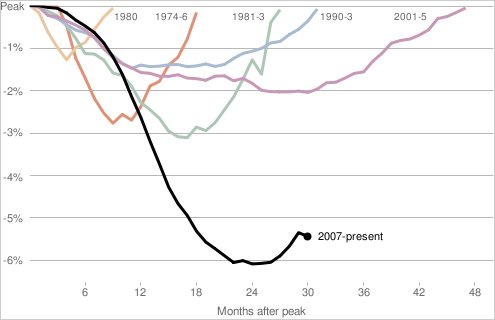Tydzień w gospodarce
Kategoria: Trendy gospodarcze
Starając się przedstawić prognozę dla gospodarki globalnej w najbliższych kilku miesiącach, ekonomiści dotychczas unikali słowa „hiperinflacja”. Chętniej mówili o recesji z podwójnym dnem (Roubini), deflacji (Schiff, Shiller, a ostatnio Krugman), a nawet Wielkim Kryzysie 2.0 (Panzner, Posner). Powoli jednak do dyskursu ekonomicznego przedostaje się termin „hiperinflacja”. A dzieje się tak m.in. za sprawą Victora Sperandeo, jednego z najbliższych partnerów biznesowych George’a Sorosa.
W czasie audycji „Fast Money” CNBC Sperandeo tłumaczył, dlaczego, jego zdaniem, zagrożenie hiperinflacją jest realne. Jako praktyk, inwestor i badacz dziejów gospodarki Sperandeo przypomina, że miało miejsce 30 przypadków wystąpienia hiperinflacji. Zwykle była związana z:
W takiej sytuacji inwestorzy mogą pozbyć się obligacji i nie czekać na ich realizację. Wówczas banki centralne będą musiały zareagować.
Przeciwko deficytowemu stymulusowi jest prof. Vernon L. Smith. Nazywa go „mordercą miejsc pracy”. W zamian proponuje drastyczne obniżenie podatków i koszty tworzenia nowych firm. Tych, które postawią na nowe technologie i rozwiązania. I zastąpią stare upadające przedsiębiorstwa.
Our best shot at increasing employment and output is to reduce business taxes and the cost of creating new start-up companies. Don’t subsidize them; just reduce their taxes even as they become larger; also reduce any unnecessary impediments to their formation. This is strongly indicated by the business dynamics program of the Bureau of Census and the Kauffman Foundation which has tracked new startup firms in the period 1980-2005. The entry of new firms net of departing firms in this period account for a remarkable two-thirds more employment growth (3 percent per year) than the average of all firms in the US (1.8 percent per year). The invigorating turmoil created by new technologies, with accompanying growth in output, productivity, and employment lead to new business formation as old firms inevitably fail. Reducing barriers to that growth encourage a recovery path which does not mortgage future output.
Przed niebezpieczeństwem nadmiernego długu strukturalnego ostrzega też Nassim Taleb, autor „The Black Swan”. Ostrzega przed tendencją wiecznego zadłużania się, którą porównuje do schematów Ponzi, które doprowadziły do bankructwa słynnego biznesmena Bernarda Madoffa. Taleb przekonuje, że w taki sam sposób mogą zbankrutować rządy, jeśli nie zrestrukturyzują finansów publicznych.
The massive one is government deficits. As an analogy: You often have planes landing two hours late. In some cases, when you have volcanos, you can land two or three weeks late. How often have you landed two hours early? Never. It’s the same with deficits. The errors tend to go one way rather than the other. When I wrote The Black Swan, I realized there was a huge bias in the way people estimate deficits and make forecasts. Typically things costs more, which is chronic. Governments that try to shoot for a surplus hardly ever reach it.
The problem is getting runaway. It’s becoming a pure Ponzi scheme. It’s very nonlinear: You need more and more debt just to stay where you are. And what broke [convicted financier Bernard] Madoff is going to break governments. They need to find new suckers all the time. And unfortunately the world has run out of suckers.
Być może rządy nie zajmują się długami, gdyż wierzą w siłę banków, które mogą wykupić ich długi? Być może, sugeruje Investors Business Daily. I dodaje, że szkoda, iż ostatnie stress testy nie były przeprowadzone na wzór motoryzacyjnych crash testów. Dr Nicolas Veron z Eurointelligence blog praktycznie podziela opinię prezentowaną w Obserwatorze przez dr Calabrię z Cato Institute, że był to zabieg PR. Bowiem przyznaje, że bez względu na wyniki stress testów banki powinny zwiększyć kapitał. I doprowadzić do silniejszej konsolidacji, tak by w przypadku bankructw jakichś krajów Europy osłonić inne.
Ultimately, history’s verdict will depend on what happens now. First, Europe’s banks still need to raise more capital, and authorities must find a way to encourage this even after having ostensibly given them a clean bill of health. The trigger for the publication was the eurozone sovereign crisis, and the aim remains to make the banking sector resilient enough to sustain a possible future public debt restructuring. Second, fragile eurozone countries must continue their efforts towards sustainable fiscal consolidation, so that if one eventually defaults, others can resist the contagion pressure.
Prof. Paul Krugman przedstawia wykres Catherine Rempell, który pokazuje wzrost bezrobocia podczas 5 powojennych recesji.
Patrząc na ten wykres trudno się nie zgodzić z twierdzeniem tych, którzy tę recesję określają mianem najpoważniejszej.
Macroblog proponuje refleksję odnośnie problemu, czy inflacja jest zjawiskiem monetarnym, na kanwie tekstu ekonomisty Davida Andolfatto z Fed Saint Louis
That’s certainly true, though most versions of the quantity theory applied to monetary policy discussions lean on broader measures of money—for no better reason than those measures help the theory fit the facts. Specifically, since the 1980s the phrase „inflation is everywhere and always a monetary phenomenon” has in effect meant „inflation is everywhere and always a monetary phenomenon when we measure money by M2”.




